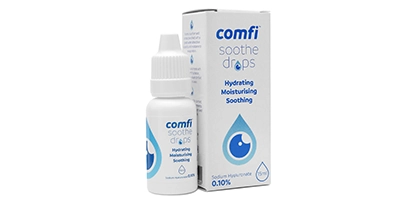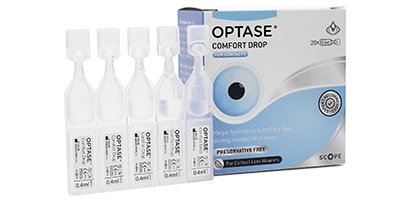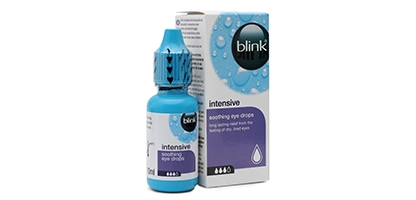What is dry eye syndrome?
Dry eye syndrome (DES) is a common eye condition that occurs when the eyes do not make enough tears or tears dry too quickly, depriving the eyes of essential moisture and hydration. Eyes deprived of moisture dry out and become red, swollen and irritated.
Dry eye syndrome is also known by a few other names. These include:
- Dry eye disease (DED)
- Keratoconjunctivitis sicca (KCS)
- Keratitis sicca
A common problem for lens wearers is that their contact lenses can create a feeling of dryness. Although contact lenses may not be the leading cause of the problem, they can make the condition more pronounced.
There are various causes for dry eyes, but most are easily dealt with by making subtle changes to your eye care routine.
Different types of dry eye syndrome
The symptoms of dry eye syndrome rarely differ, but the type and cause of the condition can vary. All types of dry eye syndrome benefit from similar dry eye treatments even if the physiology causing the condition is different.
Aqueous deficient dry eye
This type of dry eye is rare, accounting for less than 10% of cases. Aqueous deficient dry eye occurs when the eye’s tear glands (lacrimal glands) cannot produce enough tears to keep your eyes lubricated naturally. It can be painful or uncomfortable, cause redness, an itchy sensation in the eyes and impacts vision in some cases.
Evaporative dry eye
Evaporative dry eye happens when the meibomian glands malfunction. The meibomian glands are found in the eyelid margin, and they produce the oil layer of tears. This oil layer keeps tears from running off the water line of the eyelid to keep moisture close to the eye’s surface. When the meibomian glands are either blocked, shorter than usual or fail to produce sufficient volumes of oils, tears cannot rest at the surface of the eye. As a result of meibomian gland dysfunction, the water layer runs, evaporates or dries out too quickly.
Mixed dry eye
It is possible to have aqueous tear deficiency and tear instability at the same time, both of which contribute to dry eyes. When your eyes can't produce enough tears and also struggle to stabilise tears at the eye surface, the condition can become chronic.
Eyelid alignment
One common cause of DES is a mismatch in the oily secretions in the meibomian gland and the mucus and tear secreting glands of the conjunctiva and lacrimal glands. If the eyelids are not properly apposed, every time we blink the oils from the eyelid margin don’t go onto the surface of the eye properly and collect around the eyelid margin. This can cause low grade inflammation (blepharitis) as well as dry eye.
What causes dry eye syndrome?
Depending on the type of dry eye syndrome, there are a number of causal factors.
Genetic causes
Entropion and ectropion eye
People with eyelid problems like ectropion eye (where the eyelids turn outward) or entropion eye (where the eyelids turn inward) may experience evaporative dry eye syndrome if the eyelids cannot close completely. These conditions are usually inherited genetically, but they can sometimes occur after medical procedures or cosmetic surgery too.
Thyroid disorder
Commonly, people who have problems regulating thyroid gland activity have larger surface area exposed due to a bulging effect caused by swelling behind the eyes. This can make it more challenging for the eye to produce enough tears to cover the whole area of exposed eye surface.
Medical causes
Dry eyes as a symptom of an underlying illness
Dry eyes can be a symptom related to another illness, which might be temporary or life-long. Some illnesses that commonly result in dry eyes include:
- Diabetes
- Rheumatoid arthritis
- Lupus
- Scleroderma
- Sjogren’s syndrome
- Skin conditions (like eczema or rosacea)
- Reliance on Vitamin A supplements (as a result of deficiency)
Side-effect of medicine or treatment
Some medications used to address an existing health problem can have a drying side-effect on eyes. Whether it is an over-the-counter drug or a treatment programme that has been prescribed by a doctor, medicines have an impact on the body’s hormonal, chemical or homeostatic rhythm, which sometimes impacts your eyes. Some such medications include:
- Acne medicine
- Antidepressants
- Antihistamines
- Anti-inflammatory drugs
- Birth control
- Decongestants
- Diuretics
- Glaucoma eye drops
- Hormone replacement therapy (HRT)
- Hypertension medication
- Ophthalmic surgery (refractive, cataract, eyelid surgery)
- Parkinson's disease medication
Behavioural causes
Wearing contact lenses for too long
Typically, most lenses should not be worn for longer than 12 hours, unless they are extended wear contact lenses designed for continuous use. Be aware that even extended wear lenses have a specific time frame with which to be worn and typically should not exceed wearing periods of a week. Speak to your optician to determine whether or not your eyes can tolerate extended wear lenses, as they too can cause dry eye symptoms.
Not blinking enough
It is common that when you're looking at a screen, you forget to blink as you are focused on your task. The first method is to try and remember to blink more. However, most people will find this to be problematic. Another option is to keep a bottle of eye drops/artificial tears close to you and apply the drops as soon as your eyes begin to feel dry.
You could be harbouring an eye infection
Dry eyes can be an oncoming or present sign of an eye infection. Other signs to look out for are swollen eyelids, redness, itching, mucus, pimples or styes. If symptoms persist, always seek advice from your optician to seek a proper diagnosis and treatment plan.
Your contact lenses are the wrong fit
If the base curve and diameter of a lens is the wrong size, it can cause discomfort on the eye. A well-fitted lens should cover the entire cornea, move slightly with each blink but shouldn't move a lot. If it does, this can cause dryness, itchiness and irritation.
Your contact lenses are low quality
It's essential that you buy your lenses from a reputable retailer which only sells high-quality, authentic products. At Feel Good Contacts, we only purchase authentic branded lenses.
While all contact lenses have a similar manufacturing process, the quality and composition will vary. The reason for this is that some unauthorised manufacturers don't follow safety regulations. Instead, they create cheaply made lenses using materials that aren't safe for eyes.
Your contact lenses are too old
One of the advantages of daily contact lenses is that you start every day with a fresh pair of lenses, although that shouldn’t put you off monthly contact lenses or two weekly contact lenses. If cared for correctly, monthlies and two weekly replacement lenses can still provide great comfort and visibility. The key is to make sure you clean and store them properly and discard them according to the manufacturer’s recommendations.
You’re using a solution that is causing irritation
It could be that the storing or cleaning solution you’re using is causing you irritation. Speak to your optician about alternative contact lens solutions which might be more suitable for you and consider the suggested options. When you switch, the problem may go away.
Environmental causes
Air quality
The air around you can have a drying effect on eyes. Artificial elements such as central heating or air conditioning as well as long-term exposure to air pollution can leave eyes feeling tired and dry. Similarly, when your eyes are exposed to wind or smoke, these environments can trigger an immediate response like watery eyes.
Allergies
Allergies brought on by pollen and pet dander can cause the feeling of dryness and often irritate the eyes.
Exposure to chemicals
If your eyes come into contact with contaminants from harsh chemicals or their fumes, this can have an immediate or lasting effect on your eyes’ ability to produce or regulate tears.
What are the ways to prevent dry eye syndrome?
There are several measures you can take to prevent dry eye syndrome, such as implementing healthy lifestyle habits and avoiding certain risk factors that can cause dry eye. Such measures include:
Wrap-around sunglasses – Wrap style sunglasses can help to prevent dry eye buy protecting your eyes from irritants such as wind and dust.
Avoiding cigarette smoke - Cigarette smoke should be avoided at all costs. Not only can it cause further irritation to dry eyes, smoking can cause dry eyes in the first place.
Limit your screen time - Excessive screen use can limit your blinking and thus dry your eyes out. Whether you work at a computer or watch television frequently, remember to give your eyes a break.
Drink plenty of water- It is recommended you drink a minimum of 6-8 glasses of water a day to stay hydrated. Constant hydration can help maintain healthy tears.
Use artificial tears - Using artificial tears regularly is an excellent idea if you have chronic dry eye disease and find that your eyes don't produce enough tears. Even if your eyes feel ok, it's a good idea to keep them well lubricated with an extra layer of tears.
Is it dangerous to have dry eyes?
Not only can having dry eyes cause discomfort and pain, but it can also permanently damage your vision if left untreated. You are likely to be more at risk of getting an eye infection without adequate tears. A lack of lubrication means that your eyes are more likely to suffer abrasion of the corneal surface, a corneal ulcer, eye inflammation and other problems affecting your vision.
Do dry eyes cause vision loss?
A corneal ulcer can cause severe vision loss from scarring. Since dry eyes are at higher risk of corneal abrasions, the risk of vision loss related to corneal ulcers is higher too.
Can dry eye syndrome be cured?
Dry eye syndrome is not always wholly curable. Whether or not dry eye syndrome is curable depends on the cause and how severe it is. In most cases, however, it can be treated successfully, reducing the symptoms and resulting in greater comfort.
Dry eye treatments
There are many dry eye treatments available to reduce the symptoms of dry eyes. However, we would recommend consulting with your eye care specialist before committing to a particular solution. An optometrist or ophthalmologist may request that you fill out a questionnaire before prescribing you a dry eye treatment.
Following the advice of your eye care specialist and being consistent is essential for treating dry eyes successfully. Here are some possible treatment options for dry eye:
Artificial Tears
Artificial tears or other lubricating drops are often recommended for mild cases of dry eyes caused by excessive screen use or reading.
You don't need a prescription to buy artificial tears. However, it's helpful to be aware of the various ingredients and viscosity of eye drops.
At Feel Good Contacts, we offer a range of eye drops and dry eye treatments depending on the severity of the condition. Milder drops can be used by those with minor cases of dry eye, while intensive drops can be used by those who need a higher level of moisture. Some of our top sellers include:

 Offers
Offers Account
Account
 Favorite
Favorite
 Basket
Basket

 OFFERS
OFFERS



















